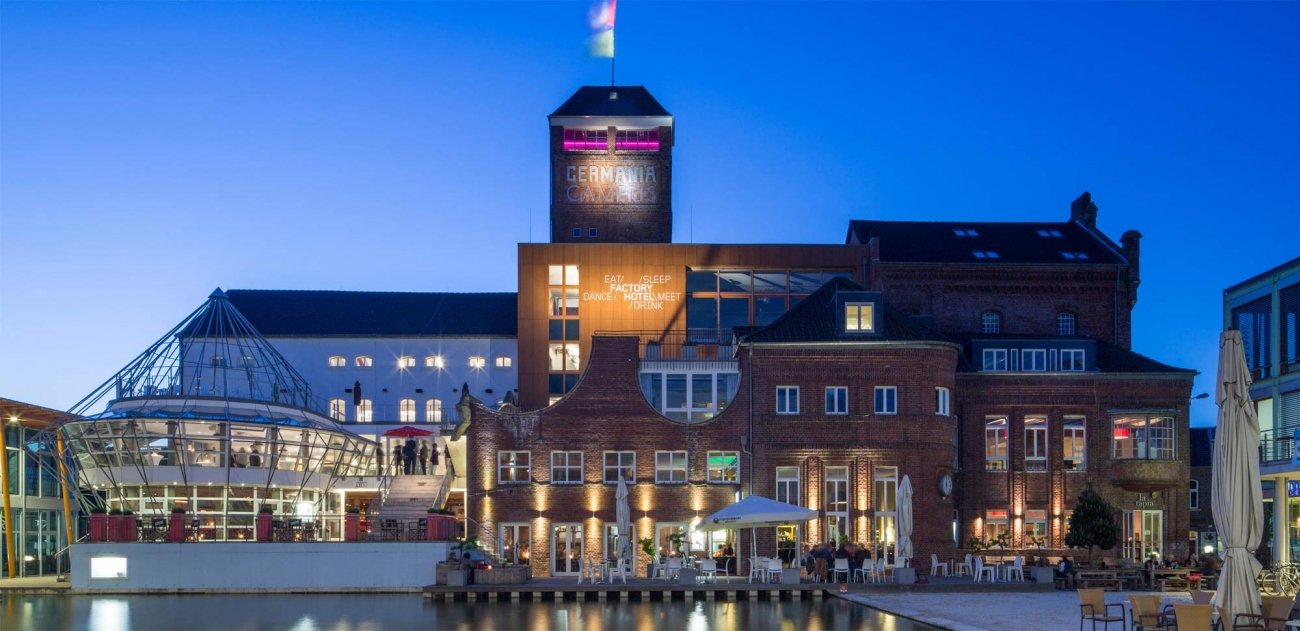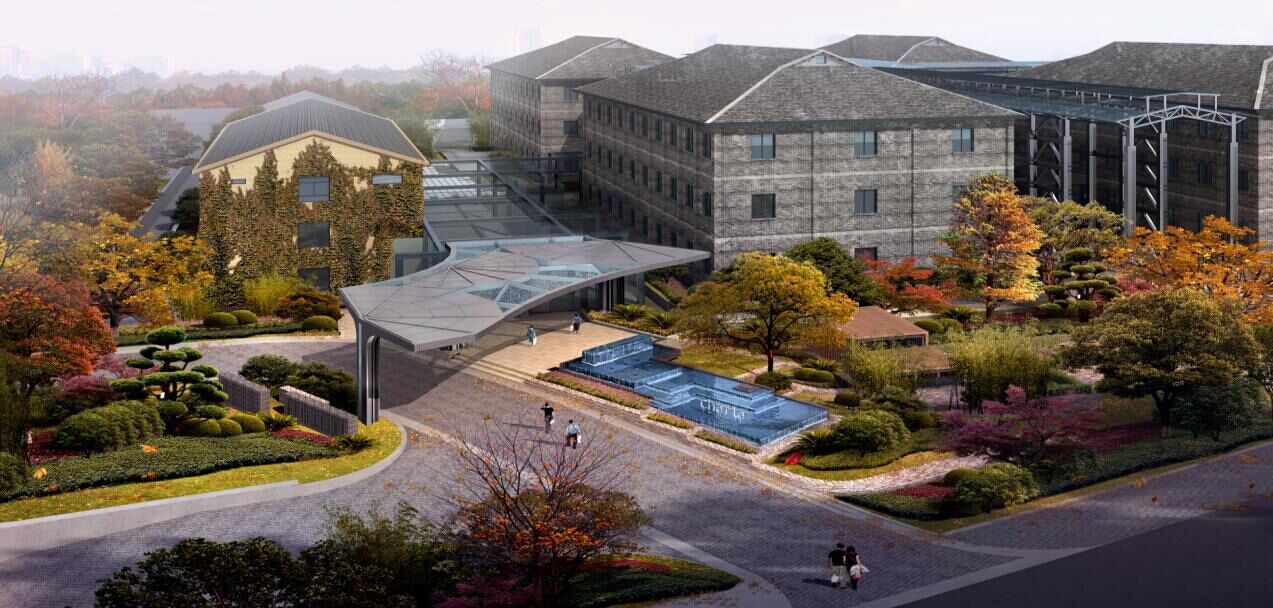羽化:创意先行,一切皆为酒店
撰文/张泽坤 Written by Alan
当城市化浪潮席卷全国,无数追梦人趋之若鹜,争先恐后来到大城市之际,在满目苍夷的大地上留下的是昔日梦想的躯壳——一座座曾被用以生产和住宿的废旧建筑。与此同时,大城市的酒店群在钢筋水泥的“人工丛林”中恍如径直矗立的“高山”,同质竞争激烈不已。
在破败与繁荣的对峙间,投资者与设计师领悟到酒店的核心定位和客户诉求后,把眼光投放到旧事物上,力求以生态恢复与设计的融合,将设计的灵魂从旧建筑的身躯上进行羽化释放,开启个性化酒店主题,而那些破败斑驳的建筑也灯火通明、光洁如新,回复了当时的盛气与风采。诚然,突破传统刻板的呈现形式后,“形散神聚”的大住宿业已然开启!

军工厂化身红旅度假区
因丰富的土地资源,政府积极推进的态度,以及特有的原生态风景,在发展中城市改造酒店一直是文旅项目的大热。
“备战备荒为人民,好人好马上三线!”上个世纪70年代的河南济源市,为进行大规模的“三线建设”,在愚公移山的故里,太行山腹地,代号531,生产火炮的军工厂应声而起,时光荏苒,因位处偏僻山区,曾汇聚着全国精英的531已成历史,遗留下来的,是空荡的厂房、礼堂、住宅楼、澡堂、食堂和当地一代人难忘的回忆。
历史等待着新生。济源市文旅集团最终接手项目,启动了位于思礼镇九里沟老兵工厂的规划改造,打造“那些年·小镇”文旅度假区,其中老兵工酒店便是其中第一个建设,计划于今年运营的项目。老厂房是一个时代的印记,是社会发展的历史“证据”,一砖一瓦都能讲出故事,改造在满足新的功能需求外,更应保留这个城市的历史记忆。
改造后的老兵工酒店西面靠山,东南临河,由6栋建筑及一个山洞组成。设有大堂、客房、餐厅、茶室、小型会议、以藏军械改造成的“库吧”酒吧等功能。一期客房25间,可容纳50人入住。另外,遵从“有山皆是园,无水不成景”的准则,改造方将水景引入老兵工酒店的院落,刚硬的军工厂房就有了灵气。或河或塘,蜿蜒曲折,穿梭于建筑之间,间有小桥连接。看似无意,实则有意的将庭院分隔整合,景观的层次变的丰富。移步换景,人在其间赏游有着更多的体验可能,在缺水的北方城市,更显珍贵。

旧仓库酝酿住宿新艺术
从成本角度而言,对旧仓库的改造,其成本相对低于重新建造的成本投入,其次,旧仓库的多建筑物构成的工业艺术规模效应,能为项目功能重新定位提供多元组合空间,甚至衍生出全新的产品,以满足个性化的需求,从而进一步挖掘其商业价值,甚至开创新的生活理念。如杭州运河契弗利酒店,就是将11栋旧置的国家厂丝仓库变成了当地住宿的新地标。
在G20峰会期间,契弗利是与其它少数五星酒店能照常营业的酒店,足见酒店的地位和实力。杭州运河契弗利酒店毗邻杭州香积寺、杭州运河博物馆、杭州丝绸博物馆等人文景点,由于是历史保护建筑,酒店的一砖一瓦都是不能随便撬砸的,外墙的砖面上留存了当年丝绸厂刻下的字迹,就如同树木的年轮一般记载了时代变迁。未经雕琢的仓储文化在这里算是得到了很好的保护,酒店也沿袭了原本青砖黛瓦的建筑风格,而主要的改造就是空间的内部,从仓库厂房变成了客房和服务设施区域。两座仓库之间架还起了一座高大的穹顶,贯穿了丽水路和大兜路。
丝绸厂的原本特性给酒店带来了不少天然优势,比如防潮隔热功能特别好。有温度的酒店空间,也是活着的城市历史。丝绸厂是酒店的前生,大运河又是海上丝绸之路的要道,因此这里的设计自然而然地与“丝绸”元素拖不了关系。大厅顶上蚕茧形状的灯,走道上的布景,大堂墙上的桑树雕饰……无不体现出历史与现代的融合。

名古刹阐释酒店禅文化
与其说工业厂房被青睐改造是因为其相对廉价的大片土地,那么喧嚣闹市中“一掷千金”的酒店改造就是看中其重要的商业区位和特殊的人文情怀。
北京除了是全国政治中心,也是传统文化重要的发源地。就如当年雍正住过的皇四子府邸,改建为如今的藏传佛教皇家寺院雍和宫,信徒游客络绎不绝,鼎盛的香火也带动了当地住宿业的发展,“去雍和宫许愿,住东景缘酒店”就此成为一道民间新谚语。
东景缘酒店的前身为智珠寺,而智珠寺的创建者就是乾隆皇帝。作为曾经最重要的藏传佛教圣地,智珠寺经过一群热衷于古建筑保护的人士改造翻新后,已经变身为京城一处集酒店、法餐、艺术展览于一身的高档场所——东景缘酒店。
“要打造东景缘酒店,首先得出类拨萃地完成这座六百年古刹的维护翻新。”东景缘创始人Juan van Wassenhove表示,酒店团队以“全方位保存历史风貌”为原则,始终坚持尊重古建本身各方面的历史价值与建筑成就。按照文物修复原则,对智珠寺的历史特色进行了最大限度的保护和再现。
修建东景缘是一种考验耐性和资金的挑战。据悉,酒店翻新整个工程历时4年,共清理出200卡车瓦砾,为翻新重建购买了80立方米的新木材,换掉了71根木柱,共修复40000块以上的棚顶瓦片。为保证修缮后的寺庙历史感,修复中尽量挑选旧材料,或是接近旧材料的材料,因为它保留了岁月应该有的味道。
从明代的藏经阁、清代的活佛居所、新中国成立后的民居,到牡丹电视机厂的转变,Juan van Wassenhove认为,创始团队以不计成本的心态进行翻新改造,不但修复了古庙的建筑,也极力保留了电视机厂后来加建的厂房,在种种难以想象的改造背后,团队只是想保留一种历史和时代的延续性。

EVERYTHING CAN BE A HOTEL
Different from traditional hotels, some special hotels are stealing the thunder from all over the world. Visionary investors and designers set eyes on those obsolete buildings such as hospitals, factories, warehouses and asylums which could shine again after the renovation. Breaking out of the tradition and stereotype of hospitality, the lodging industry is going to steer the ship and embark a new era. Are you ready?
Arsenal turned into a patriotic tourism resort
Hotels renovation has been really popular among developing cities especially inland cities, for abundant land resources, unique and natural scenery and great supports from local governments.
A grand arsenal was built in the back-land of in Henan Province in 1970s for army force storage. But after the war period, it becomes nothing but a unforgettable memory. History await rebirth. Eventually the place was transformed into a nostalgic cultural tourist spot, keeping the historic memory and also performing its full play. The renovated hotel constitutes six buildings and a cave, taking good advantage of the local terrain and special scenery. Therefore, the arsenal has reborn into a resort.
Warehouse breeds new art of hotels
Cha’fle Canal Hotel Hangzhou was transformed from 11 old state-owned silk warehouses, and turns them into a new icon of local accommodation. Protecting their full historic characteristics especially silk culture and special building style, the renovation falls into the interior of the hotel and perfectly blends modern style and history.
Ancient temple interprets Buddhist culture of hotel
That remote and abandoned places to be transformed is because of relatively cheap land, but renovating those which in urban areas is due to their business locations and special cultural complex.
Established by Qian Long Emperor in Qing Dynasty, the 600 years old Zhi Zhu Temple was renovated into the Temple Hotel Beijing, covering hotels, French restaurants and art exhibitions. “The building of this hotel lies in the perfect maintenance and renovation of Zhi Zhu Temple”, reckoned Juan van Wassenhove, the founder of the Temple Hotel.
Costing four years and 80 cubic meters new timber, the project has spared no efforts to maintain the historic sense of it. Among all those transformations, the team tried to present a continuity of history.
Arsenal turned into a patriotic tourism resort
Hotels renovation has been really popular among developing cities especially inland cities, for abundant land resources, unique and natural scenery and great supports from local governments.
A grand arsenal was built in the back-land of in Henan Province in 1970s for army force storage. But after the war period, it becomes nothing but a unforgettable memory. History await rebirth. Eventually the place was transformed into a nostalgic cultural tourist spot, keeping the historic memory and also performing its full play. The renovated hotel constitutes six buildings and a cave, taking good advantage of the local terrain and special scenery. Therefore, the arsenal has reborn into a resort.
Warehouse breeds new art of hotels
Cha’fle Canal Hotel Hangzhou was transformed from 11 old state-owned silk warehouses, and turns them into a new icon of local accommodation. Protecting their full historic characteristics especially silk culture and special building style, the renovation falls into the interior of the hotel and perfectly blends modern style and history.
Ancient temple interprets Buddhist culture of hotel
That remote and abandoned places to be transformed is because of relatively cheap land, but renovating those which in urban areas is due to their business locations and special cultural complex.
Established by Qian Long Emperor in Qing Dynasty, the 600 years old Zhi Zhu Temple was renovated into the Temple Hotel Beijing, covering hotels, French restaurants and art exhibitions. “The building of this hotel lies in the perfect maintenance and renovation of Zhi Zhu Temple”, reckoned Juan van Wassenhove, the founder of the Temple Hotel.
Costing four years and 80 cubic meters new timber, the project has spared no efforts to maintain the historic sense of it. Among all those transformations, the team tried to present a continuity of history.
本网站部分图片来源于网络,如有侵权,请联系780236430@qq.com ,我们会在5个工作日内查证删除。图片其版权均归原作者及其网站所有。


